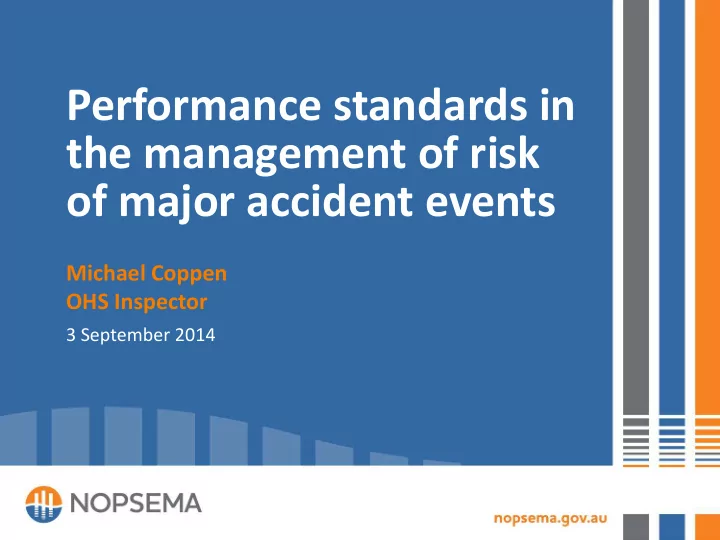

Performance standards in the management of risk of major accident events Michael Coppen OHS Inspector 3 September 2014
Date 2
OPGGS(S) Regulations Definition • Performance Standard means a standard, established by the operator, of the performance required of a system, item of equipment, person or procedure which is used as a basis for managing the risk of a major accident event. Regulations • 2.5 (3) (i) – The Safety Case for the facility must also contain a detailed description of the safety management system that specifies the performance standards that apply. • 2.20 (2) (b) – The (emergency response) plan must specify the performance standards that it applies. 4
5
Developing Performance Standards for Control Measures 8
Basis for Design, Safety Case Assurance Statutory, Class & Engineering Requirements – Requirements – Flag Standards and FSA, SMS RCM, RBI, CM Requirements Specifications Performance Standard Measurable and Auditable • Facility Specific • E.G. SMART • Format Functionality • FSA - Formal Safety Assessment SMS – Safety Management Systems Availability / Reliability • RCM – Reliability Centred Maintenance RBI – Risk Based Inspection Survivability • CM – Condition Monitoring Dependency / Interaction • 9
Developing Performance Standards for Control Measures • Functionality - What the Control Measure must do and the criteria it must achieve, • Availability / Reliability - Assuring its functional capability • Survivability - Will it continue to function, if needed, after a hazardous event occurs, • Dependency / Interaction - What other Control Measures are needed to allow its functional capability, AND • How the above items will be/are ‘Assured’ e.g. Design/Technical Review, QA/QC, Maintenance, Inspection and Testing, Audits etc. 10
Design, Procurement, Manufacture, Fabrication, Performance Safety ` Construction, Standards Goal Commissioning Manage Deviations ` a) Technical Criteria / Functionality Function Assurance b) Operating Guidance Change Management ` What the control measure must do and the criteria it must achieve and Accidental Damage Availability Criteria / Operational Envelope Function Assurance and Guidance Reliability Protect Against Recognised Failure Modes Assuring its functional capability Maintenance, Inspection, Test Integrity Envelope Fire, Explosion, Collision, Survivability Event Component Criteria Assurance ` Environmental Damage, Accidental Damage Will it continue to function, if needed, after a hazardous event occurs Dependency Performance System Reason / Interaction Standards 12 What other control measures are needed to allow its functional capability
Performance Standard Development Issues • Full functionality of control measure not defined e.g. start systems of emergency generators missing, • Performance criteria not fully specified, thus difficult to measure e.g. closing requirement / time for temporary refuge fire dampers not specified, • Referencing marine standards (Class / IMO) as the performance standard e.g. IMO MODU Code for active fire protection states “capacity of required pumps should be appropriate to the fire fighting service” i.e. no flow and pressure performance criteria specified. 17
Performance Standard Development Issues – cont. • Assurance tasks not fully specified e.g. maintenance tasks for emergency switchboard not referenced, • Not enough input from engineering discipline technical authorities – risk / safety engineers drive development. 18
Date 19
Apply and Maintain Control Measures Critical Asset RCM, RBI, CMMS Maintenance Register CM Execute Assurance Develop Task / Scope / Activities Plans / Frequency Routines Schedule History Plant and Equipment Optimise Formal Control Performance Standards Safety Measures Assessment RCM Reliability Centred Maintenance RBI Risk Based Inspection CM Condition Monitoring CMMS Computerised Maintenance Management System
Performance Standard Implementation Issues • Performance standards not being aligned and optimised with assurance activities e.g. no GAP analysis and optimisation of maintenance management system, • Assurance activities not testing and recording performance criteria e.g. deluge and sprinkler systems coverage not being adequately tested and recorded, 21
Performance Standard Implementation Issues – cont. • Assurance activities not fully defined / referenced in performance standards e.g. key components of control measure assurance not in performance standards – UPS systems, • Availability / reliability of control measure not being measured and assessed e.g. equipment uptime, equipment performance, equipment defect management, maintenance completed on time, maintenance backlog, maintenance deferral. 22
Lack of Availability / Reliability of Control Measure • Technical Degradation, Failure, Accidental Damage, Loss of Redundancy. • Operating Operating Conditions, Environmental Conditions, Out of Service for Maintenance. • Manage Deviations/Technical Change Design Review(Outside Original Design Envelope), Operational Review (Outside Originally Specified Operating Conditions). • Contingency Planning (Short Term Control Measures) 23
On-going Assessment of Control Measures Performance • Monthly assessment of control measures performance, • Annual review and assessment of control measure performance, • Safety management system audit of management of control measures, • Independent verification of control measures performance. 24
Summary Robust development and effective use of performance standards significantly contributes to the demonstration that control measures for the prevention and mitigation of major accident events are being appropriately and adequately managed Further Information GN0271 - Guidance note on control measures and performance standards: NOPSEMA website safety section safety case section safety case guidance notes 25
Any questions?
Recommend
More recommend